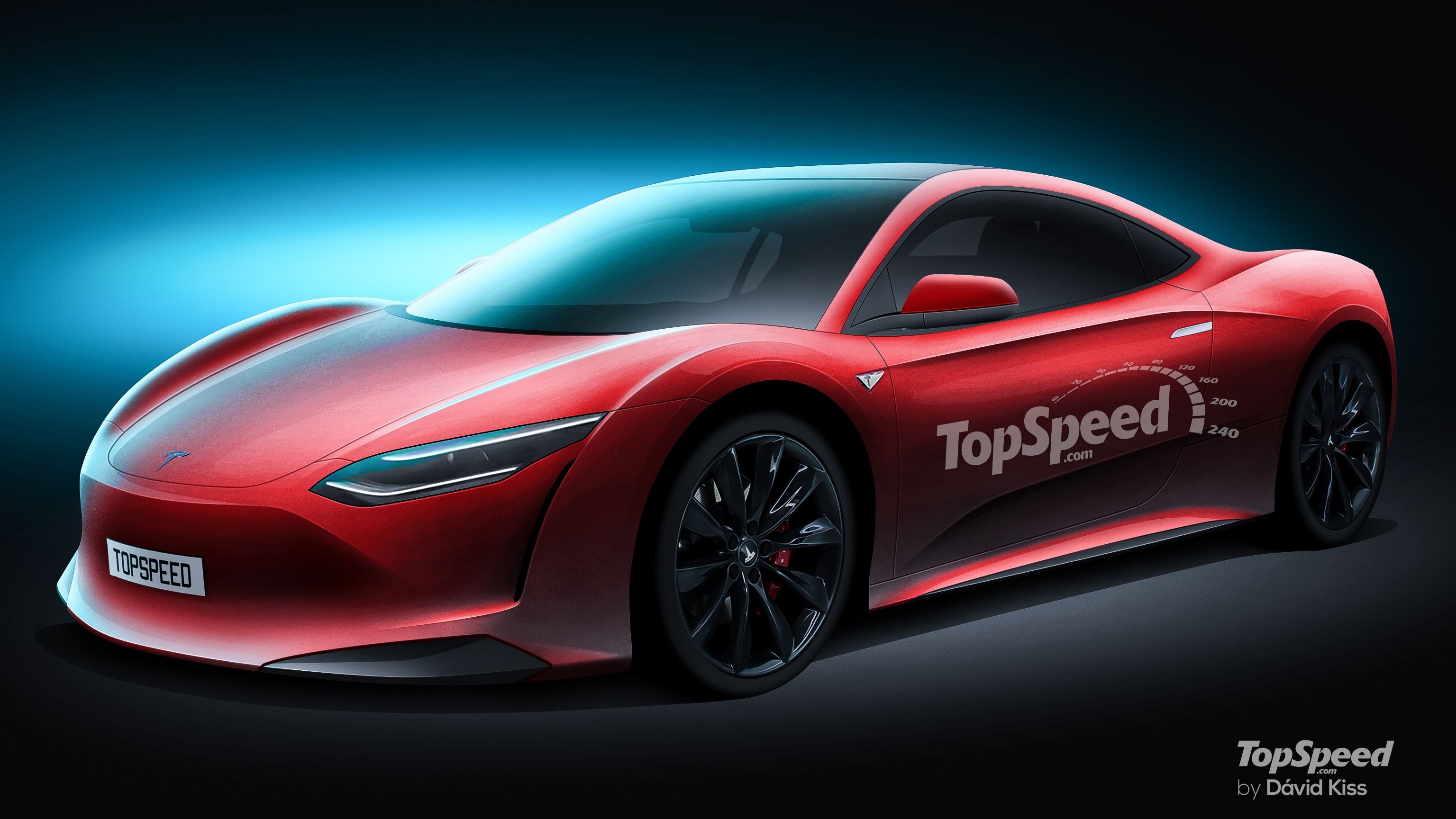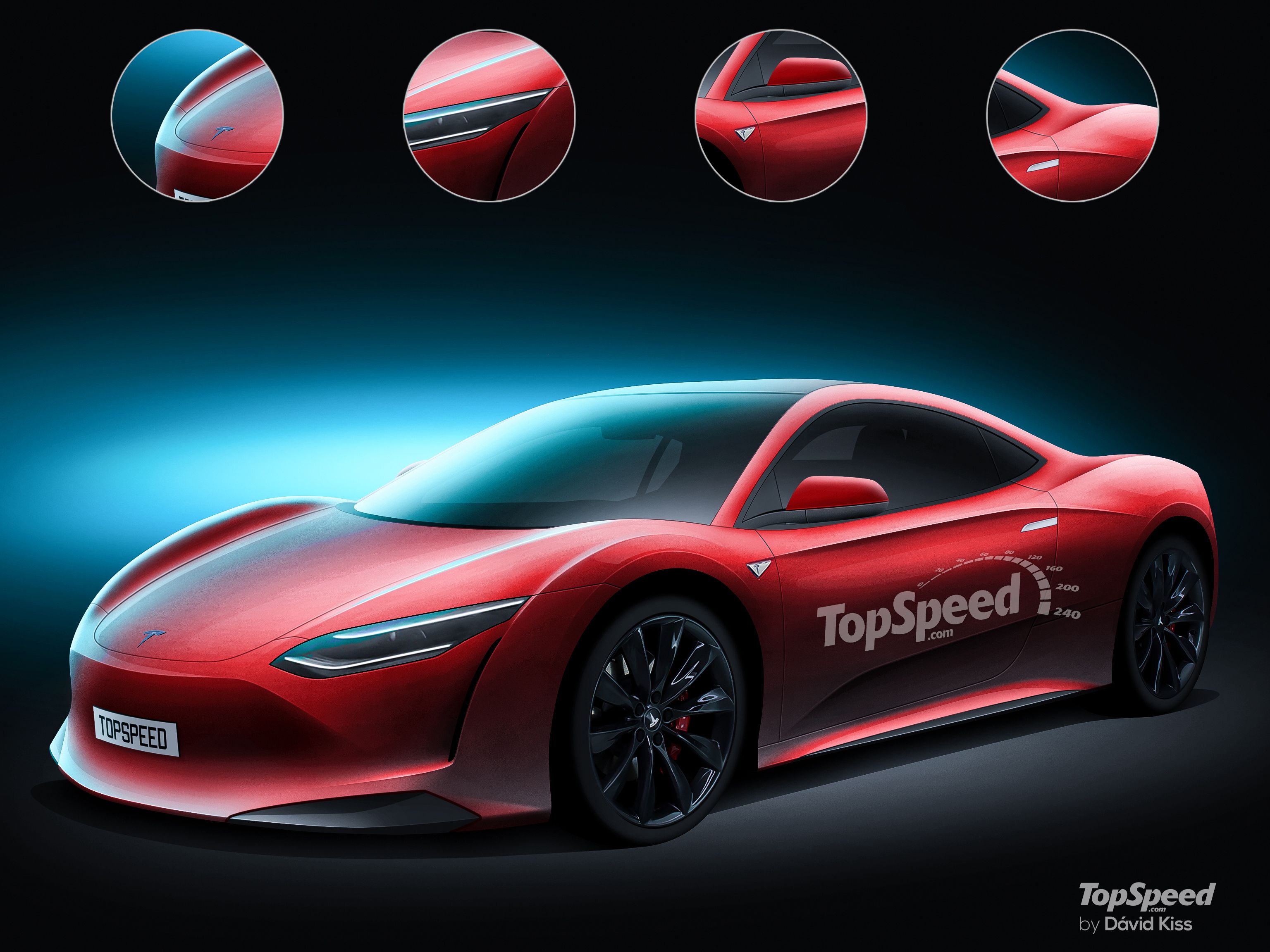It seems almost like almost every other day now brings news about some physics-defying all-electric supercar. Outrageous output figures and broken records are pretty much the norm in this segment, with cars like the NextEV Nio EP9 or Rimac Concept_One setting new standards in electron-powered performance. Tesla is active in this space as well, earning a spot on our list of Top 5 All-Electric Performance Cars with its the venerable Model S P100D. The Model S might be a sedan, but it’s still got insane speed potential, posting a face-melting 2.3-second time in the 0-to-60 mph benchmark. Impressive? Certainly. But what if we went beyond the P100D and probed what was really possible with a few electric motors and an enormous battery pack? What about a true-blue Tesla supercar, a halo model with just two doors and a spec sheet capable of laying waste to all things internal combustion? What would that look like?
It’s a tempting proposition, but right away, there’s a problem. Tesla has adopted a “top-down” approach wherein the more expensive models come out prior to the less expensive models (for example, the Model S preceded the Model 3). So where does a super car fit into that equation? Obviously several years down the line, if at all, but that said, a supercar halo model would do well amongst well-heeled EV enthusiasts, not to mention bring even more attention to the California-based automaker. Sound good? We think so.
Continue reading to learn more about the Tesla Supercar.
2020 Tesla Supercar
- Make: Array
- Model: 2020 Tesla Supercar
- Horsepower: 750
- Torque: 1150
- [do not use] Vehicle Model: Array
Exterior
Note: Tesla Model S P100D pictured on the left, Tesla Supercar rendering on the right.
While it’s true that the slinky, curvaceous, red-hot coupe rendering you see here is indeed the product of our collective imagination, we didn’t just pull the lines out of thin air. By now, the Tesla styling language is pretty well established. Just look at the Model X and Model 3 –
Note: Tesla Model X pictured on the left, Tesla Model 3 pictured on the right.
Starting in front, we find the traditional Tesla headlights, with thin, drawn-back housings that look as though they were etched into the fenders with lasers. The lighting element will use LED’s, which also includes the horizontal daytime running lights.
Per usual, the front end is a solid, smoothed-out bumper, without the traditional grille and intake you’d find on an ICE-powered vehicle. Rather, a curved bumper like this provides minimal aero drag, simultaneously upping maximum miles between charge-ups and increasing top speed.
At the same time, the bumper does get a few features to help it stick at speed, with an extended lower splitter and black side strakes. Thin intakes line the fenders ahead of the wheels to keep the hot bits nice and chilly.
The stance is reminiscent of a variety of supercar competitors, including models like the McLaren 720S, Ferrari 488 GTB, and Porsche 918 Spyder. It’s impossibly low, enormously wide, and very muscular in the corners. The fenders seem to collect the most character lines, joining creases that start in the front bumper and hood line, sending them rearwards and into hugely flared rear fenders. The lower side skirts jut out to keep that pesky atmosphere where it needs to be. The wheels are 20-inches in diameter, finished in black and bearing the traditional Tesla turbine design, the same look you get on the Model S.
Details include a triangular Tesla fender badge and flat door handles.
While we rendered a hard top coupe for this possible Tesla Supercar, it’s entirely possible the future halo car will be a roadster instead. After all, the first-ever Tesla model was a Lotus-based open top, and Elon Musk has dropped a few hints a fresh-gen iteration could be in the cards. A model like that would obviously be a bit less streamlined and a little heavier, but would definitely appeal to affluent buyers looking to mix extra blue sky into the equation.
Interior
Note: Tesla Model S pictured here.
Any supercar worth its bedroom poster should be strictly limited to two seats (unless, of course, you’re talking about legendary McLaren F1, which had three seats, but as well know, the rules don’t really apply to the F1). As such, a Tesla Supercar would most likely follow suit, with just a pair of highly bolstered sports seats inside the cabin.
The layout would be dominated by a vertical touchscreen along the central tunnel, which would act as the primary user interface for the car’s various infotainment and onboard features. The steering wheel would be a flat-bottom affair, with a more aggressive shape and smaller diameter than what you get with the Model S. Behind the wheel will be a digital gauge readout providing a deluge of information to the driver, including everything from performance numbers and figures (lap times, horsepower output, etc.), to system settings and vehicle status (charge levels, current drive mode, etc.).
Materials used will be all high-end, with premium upholstery options, wood and carbon fiber surfaces, and brushed metal trim. The look will be simple and elegant, like the rest of Tesla’s designs, without a lot of the clutter you get with most other supercars.
Features like the Bio-Weapon Defense Mode air filtration system, which cleans cabin air with a medical-grade HEPA filter, as well as adaptive dynamic lighting, will also be carried over from the Model S.
Of course, there should be some pretty advanced autopilot and autonomous features as well. We wouldn’t be surprised to see lane keep assist, adaptive cruise control, parking assist, and all the other goodies that usually make the list. Maybe a Tesla Supercar would even come with a “racer” mode for the track to help you keep it out of the tire wall while hunting for apexes.
Drivetrain
Note: Tesla Model S pictured here.
Tesla offers a variety of drivetrain options for the modern Model S, with configurations including the 75, 75D, and 100D. At the moment, the fastest Tesla on offer in the venerable Model S P100D, which gets a sizable 100-kWh battery pack and dual-motor drive system that bless it with an impressive 588 horsepower and downright absurd 922 pound-feet of torque (at least according to our friends over at Note: Tesla Model S pictured here., who put one on a dyno recently). And while that might seem like more than enough for a Tesla Supercar, we wouldn’t be surprised if Tesla somehow managed to find a way to cram in even more juice.
Here’s the proposal – the P120D, with a dual-motor drive and a 120-kWh battery under the floor. Output would probably clock in at around 700 to 750 horses and 1,150 pound-feet of torque, which when applied liberally would result in a 0-to-60 mph time of less than 2 seconds. Top speed would hit at around 200 mph.
Sounds ludicrous, does it not? Well, that’s the point – the Tesla Supercar takes things all the way to Maximum Plaid.
Not only that, but the current Tesla Model S P100D is just a stone’s throw away from hitting those numbers right now, anyway. The 0-to-60 mph sprint is already completed in just 2.3 seconds, with the quarter mile blitzed in 10.5 seconds at 125 mph.
An extra large battery would certainly go a long way towards improving these numbers, but so would a lighter chassis. We predict the Tesla Supercar will be a bit bigger than the Model S, with a lower, wider, stance that might provide extra space for batteries, but superfluous features will get toned back a bit in favor of more speed, thus cutting mass in the long run.
A bigger battery would result in more miles as well, with upwards of 400 miles per charge possible, especially if Tesla continues to pioneer new battery technology and increase overall energy density.
Road & Track0}
The current crop of Teslas on the market don’t come cheap, especially if you go for the high-end models. The Model S P100D, for example, comes with a price tag of $140,000.
That’s certainly not chump change, and but in the supercar segment, you’ve gotta readjust your expectations slightly. All told, we wouldn’t be surprised to see something like the above-featured Tesla Supercar tagged with a price somewhere between $200,000 and $250,000 a pop.
Prices
NextEV Nio EP9
NextEV is a China-based electric vehicle producer that’s been making some pretty big waves as of late. The company’s supercar offering is called the Nio EP9, and as you can probably tell from the picture, it’s inspired by the land-based spaceships that frequent the grid at Le Mans. The whole thing is made from carbon fiber, while four electric motors drop the output to the pavement. As much as 1,341 horsepower is available via the long skinny pedal on the right, providing a 0-to-62 mph time of 2.7 seconds and a top speed of 195 mph, while active aero, active suspension, and a huge amount of tire help it pull an outrageous 3 g’s in the corners. Pricing is set at around $1.2 million.
Rimac Concept_One
Rimac is another up-and-coming name in the world of all-electric performance cars, with the Concept_One offered as a two-door eater of gas burners. Materials include the usual aluminum and carbon fiber bits, while motivation is derived from 1,072 horsepower and 1,180 pound-feet of torque, all of which reaches the ground though an advanced AWD system and torque vectoring set-up. All told, the Concept_One will hit 62 mph in 2.6 seconds and reach a top speed of 221 mph. Pricing is set at around $950,000.
Read the full review here.
Conclusion
At first glance, a Tesla Supercar might seem a little far-fetched, but if you think about it, the California-based automaker has a long history of offering up some pretty crazy products. For example, the Model S might be mainstream now, but when it was first introduced in 2012, the industry was completely blown away. Now, the brand also has an SUV and a compact sedan, with a possible pickup truck and semi on the way.
What’s more, folks are already clamoring for a Tesla with even more go under the hood (er, under the floor?), as evidenced by the GoPuck Model S that tackled Pikes Peak last year and the all-Tesla Electric GT spec race series slated to launch in August.
So how would something like what we’ve imagined above line up against the competition? For starters, the Tesla would have a clear edge when it came to straight-line speed, but in the corners, the Nio EP9 and Concept_One would most likely leave it for dead, given the Tesla’s greater weight, inferior aero and downforce, and simplified suspension set-up.
But that’s okay – it would still sell by the boatload here in the U.S.
What do you think? Could the world use a Tesla Supercar? Should it be a hardtop, or a roadster? Let us know in the comments.






